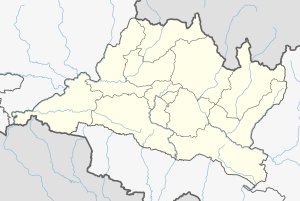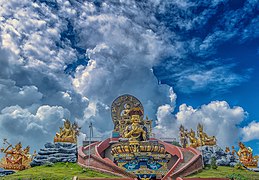|
Nagarjun Municipality
Nagarjun is a municipality in Kathmandu District in Bagmati Province of Nepal. It was formed on 2 December 2014 by merging the former VDCs of Bhimdhunga, Ichangu Narayan, Ramkot, Syuchatar and Sitapaila.[1][2] The office of the municipality is located at Harisiddhi, Sitapaila. There are ten wards in the municipality. GeographyIt is surrounded by 13,14, 15 and 16 number wards of Kathmandu Metropolitan City on the east, Dhading District on the west, Tarkeshwar Municipality on the north and Chandragiri Municipality on the south. The area of the municipality is 29.8 square kilometres (11.5 sq mi) and the average altitude is 1,300 metres (4,300 ft) to 2,500 metres (8,200 ft) above sea level.[3] DemographicsAt the time of the 2011 Nepal census, Nagarjun Municipality had a population of 68,863. Of these, 71.1% spoke Nepali, 11.3% Newar, 8.9% Tamang, 2.0% Gurung, 1.4% Magar, 1.3% Maithili, 0.6% Rai, 0.6% Sherpa, 0.6% Tharu, 0.5% Bhojpuri, 0.4% Hindi, 0.2% Limbu, 0.2% Tibetan, 0.1% Doteli, 0.1% Kham, 0.1% Thakali, 0.1% Urdu and 0.2% other languages as their first language.[4] In terms of ethnicity/caste, 23.6% were Chhetri, 22.0% Hill Brahmin, 17.5% Newar, 13.6% Tamang, 4.8% Magar, 3.9% Sanyasi/Dasnami, 3.3% Gurung, 1.6% Thakuri, 1.4% Rai, 1.1% Tharu, 0.8% Kami, 0.8% Musalman, 0.7% other Dalit, 0.6% Sherpa, 0.5% Damai/Dholi, 0.4% Limbu, 0.3% Gharti/Bhujel, 0.3% Thakali, 0.2% Badi, 0.2% Ghale, 0.2% Majhi, 0.2% Sarki, 0.2% Yadav, 0.1% Bhote, 0.1% Terai Brahmin, 0.1% Dhanuk, 0.1% Dura, 0.1% Hajjam/Thakur, 0.1% Halwai, 0.1% Kalwar, 0.1% Koiri/Kushwaha, 0.1% Kumal, 0.1% Marwadi, 0.1% Sunuwar, 0.1% Teli, 0.1% other Terai and 0.2% others.[5] In terms of religion, 82.3% were Hindu, 14.1% Buddhist, 2.4% Christian, 0.8% Muslim, 0.3% Kirati and 0.1% others.[6] In terms of literacy, 85.1% could read and write, 1.7% could only read and 13.1% could neither read nor write.[7] The population of the municipality grew to 115,437 at the 2021 Nepal census. Around 99.4% of the residents were Nepali citizens and 89.2% were literate in 2021.[8] Popular sites
References
External links |
||||||||||||||||||||||||||||||||||||||||








